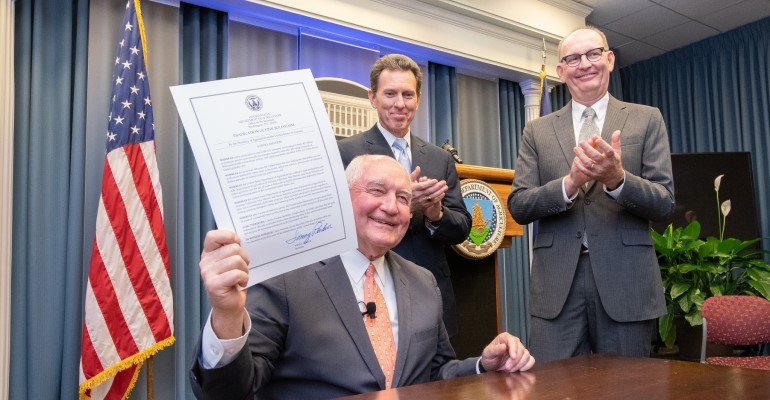Cotton pink bollworm no longer an economic threat
USDA lifts quarantine for pink bollworm, easing restrictions on domestic and international movement of U.S. cotton.
October 19, 2018

U.S. cotton is free — after more than 100 years — of the devastating pink bollworm, according to an announcement from the U.S. Department of Agriculture.
Agriculture Secretary Sonny Perdue, who made the announcement Friday at a ceremony in Washington, D.C., said the pink bollworm has cost U.S. producers tens of millions of dollars in yearly control costs and yield losses.
USDA explained in a statement that, “thanks to rigorous control and regulatory activities carried out by USDA, state departments of agriculture, the U.S. cotton industry and growers, the pink bollworm has been eliminated from all cotton-producing areas in the continental United States. As a result, USDA is lifting the domestic quarantine for pink bollworm, relieving restrictions on the domestic and international movement of U.S. cotton.”
“Removing pink bollworm regulations eases the movement of cotton to market both domestically and internationally because farmers will have fewer restrictions to deal with, like fumigation requirements. This welcome development comes just as cotton harvest is in full swing across the southern United States,” Perdue said.
Perdue noted that cotton growers were critical to this success, banding together to carry out a coordinated, multi-state program and shouldering 80% of the program’s cost. That effort, he said, “demonstrates the value of partnership, investment and putting our research close to and beside the farmers we serve.”
During the ceremony, Clyde Sharp, an Arizona grower who co-chairs the National Cotton Council’s (NCC) Pink Bollworm Action Committee with California grower Ted Sheely, said, “On behalf of the cotton producers who have battled the pink bollworm most of their career and those that battled the pink bollworm before us, we thank everyone that has made this day possible. Amazingly, the pink bollworm eradication program relied mostly on insect control measures that were least disruptive to the agro-ecosystem.”
According to USDA, the pink bollworm was first detected in the U.S. in 1917 in Hearne, Texas, and by the mid-1950s, the pest had spread to surrounding states, eventually reaching California in 1963. In 1955, USDA’s Animal & Plant Health Inspection Service (APHIS) established domestic pink bollworm regulations. At the height of the program, 10 states (Arizona, Arkansas, California, Louisiana, New Mexico, Oklahoma, Texas, Nevada, Mississippi and Missouri) were quarantined for this pest. Many of these infestations were suppressed through cooperative federal, state and industry programs. By 2003, only Arizona, California, New Mexico and Texas remained under regulation.
Eradication of pink bollworm took years of committed research by USDA’s Agricultural Research Service (ARS) and included planting transgenic cotton, using insect pheromones to disrupt mating, releasing sterile insects to prevent reproduction and conducting extensive surveys. Many of the research findings by ARS became management strategies APHIS and cotton producers used in their battle against pink bollworm.
NCC president and chief executive officer Gary Adams, who also participated in the ceremony, said NCC appreciates the united effort of its producer members, the dedication and coordination of APHIS staff, the collective contributions of many scientists and the federal funding support from Congress that enabled APHIS to complete this monumental task.
“The pink bollworm, a destructive insect pest of cotton that once required multiple insecticide applications while continuing to reduce yields, is no longer present in U.S. cotton production,” Adams said. “The benefits of this program are shared by society, the environment and the united producer membership who led this battle to victory.”
The U.S. is a world leader in cotton production and trade. According to industry estimates, the U.S. cotton industry accounts for nearly $27 billion in products and services annually, provides hundreds of thousands of jobs across many sectors and supplies nearly one-third of the raw cotton that is traded globally.
You May Also Like



